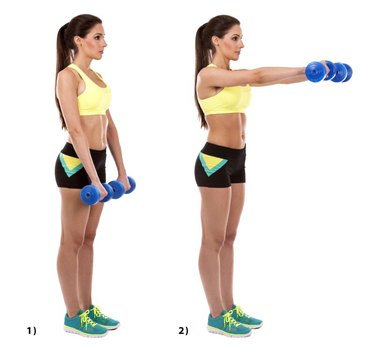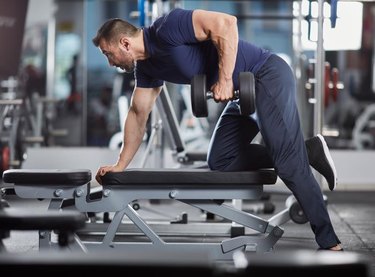
If you've ever dislocated your shoulder, there's a good chance you have anterior shoulder instability. Your shoulder is surrounded by a capsule, much like a tennis ball wrapped in cling-wrap. When the front of the capsule stretches out, it no longer holds the ball in the socket securely. Anterior instability can also develop over time from repetitive activities such as overhand pitching, swimming, gymnastics and contact sports.
Once these structures are stretched out, they stay that way. However, muscles around the shoulder joint also help keep the ball in the socket. Strengthening muscles that pull the ball back into the socket can improve stability of your anterior shoulder.
Video of the Day
Video of the Day
Read more: Dislocated Shoulder & Rehab Exercise

Front Raises
Front raises strengthen muscles that move your arm out in front of your body. This exercise also pulls the ball back into the socket of your shoulder, reducing your risk of further injury. Strengthening these muscles will improve your ability to lift things like groceries and laundry baskets.
Step 1
Stand up straight holding one dumbbell in each hand. Keep your elbows straight and rest the dumbbells in front of your hips.
Step 2
Slowly raise your arms in front of you until they are shoulder-height. Hold this position for 3 seconds, then lower back down.
Step 3
Repeat 10 times, working up to three sets.

Lateral Raises
Lateral raises strengthen shoulder abduction -- movement of your arm away from your side. Perform lateral raises with both arms simultaneously or one arm at a time.
Step 1
Hold one dumbbell in each hand and stand with your feet shoulder-width apart.
Step 2
Rotate your arms until your thumbs point away from your body. Keeping your elbows straight, raise the dumbbells out to the sides until your arms are shoulder-height.
Step 3
Hold this position for 3 seconds, then slowly lower back down. Repeat 10 times and work up to three sets in a row.
Internal Rotation
Internal rotation exercises strengthen muscles that turn your arm in toward your body. This exercise is easily performed with a small dumbbell. The motion is important for putting on a belt and tucking your shirt in behind your back.
Step 1
Lie on the side of the body you are exercising with a pillow to support your head. Holding the dumbbell, bend your elbow to 90 degrees and bring your upper arm in next to your body.
Step 2
Rotate your forearm in toward your body until the weight is pointed toward the ceiling. Hold for 2 to 3 seconds, then slowly lower back down.
Step 3
Repeat 10 times, working up to three sets in a row.
External Rotation
External rotation exercises strengthen muscles that turn your arm out and away from your body. Perform this exercise with your upper arm next to your body. If done improperly, this exercise could increase your risk of dislocation by putting too much stress on the anterior shoulder.
Step 1
Lie on your side with the exercising arm toward the ceiling.
Step 2
Grasp the dumbbell and bend your elbow to 90 degrees. Rest your forearm against your torso.
Step 3
Keeping your upper arm next to your body, rotate your forearm away from you until the dumbbell is at least parallel to the floor. Hold for 2 to 3 seconds, then slowly lower back down.
Step 4
Repeat 10 times, working up to three sets in a row.

Rows
Strong shoulder blade muscles are important for shoulder stability. Rows target these muscles. Without these muscles, you would not be able to reach all the way overhead. They also help keep the ball positioned correctly in the socket of your shoulder joint.
Step 1
Lie on your stomach on a firm surface. Grasp the dumbbell and dangle the exercising arm off the edge of the surface.
Step 2
Squeeze your shoulder blade in toward the opposite side and pull your elbow straight up toward the ceiling as high as possible. The dumbbell should move straight up. Do not allow your arm to move forward or backward.
Step 3
Squeeze for 2 to 3 seconds then slowly lower the weight back down.
Step 4
Repeat 10 times, working up to three sets in a row.
- World Journal of Clinical Cases: Recurrent Anterior Shoulder Instability: Review of the Literature and Current Concepts
- American Academy of Orthopaedic Surgeons: Rotator Cuff and Shoulder Conditioning Program
- Journal of Orthopaedic & Sports Physical Therapy: Shoulder Instability: Management and Rehabilitation
- Centers for Orthopaedics: Rotator Cuff Home Program
- American Academy of Orthopaedic Surgeons: Fundamental Shoulder Exercises
Is this an emergency? If you are experiencing serious medical symptoms, please see the National Library of Medicine’s list of signs you need emergency medical attention or call 911.